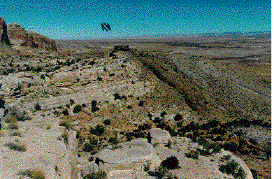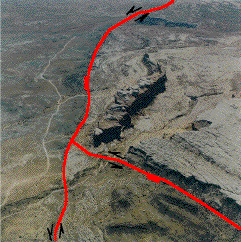
Duration - 01/01/94- 31/12/96
Funding - Multi-company project supported by:
Co-ordinator - Dr Alistair Fletcher of PSTI (now the Centre for Marine and Petroleum Technology, CMPT).
Research Partner
Summary - The study investigated the distribution of diagenesis around the Moab Fault, east-central Utah, U.S.A. Located in the NE of the Paradox Basin, the Moab Fault is a ca 45km long, salt-related, normal fault of ca 960m surface throw that displaces an heterogeneous sedimentary sequence of Pennsylvanian to Cretaceous age (Foxford et al. 1996). The fault extends north-westwards from Moab-Spanish Valley salt anticline along the south-western flank of a salt withdrawal syncline. The surface trace comprises a simple southern segment joined to a series of splays at branch-points in the north. Maximum surface throw occurs in the south where the fault is associated with a footwall high and with a hangingwall anticline (Moab Anticline). In this southern area, throw increases rapidly with depth to a maximum of ca 1.5km at Top Salt. Faulting was driven by salt migration and extended from the Triassic to early Tertiary.
In figure above, aeolian sandstones (left) adjacent to Moab Fault can show accentuated iron oxide reduction (with colour change from red to white). At this locality fault throw is ca. 350m and normal drag is developed within hangingwall.
Several deep canyons cut across the fault zone and its related sediments and provide extensive lateral exposure of both footwall and hangingwall sequences. Up to 90m of vertical exposure is available at any one locality and this, together with the along strike displacement variation, enables variation in lithological juxtaposition to be examined along the length of the fault. The readily accessible 2-D (and in some cases 3-D) exposures allow sampling of the fault zone and assessment of lateral variation both along the fault and with increasing distance from the fault up to distances of several hundred metres (Foxford et al. 1996).
Associated with the fault is a distinctive type of diagenesis involving both cementation and reduction of the faulted sequence, particularly the high porosity, aeolian-fluvial sandstones of Lower to Middle Jurassic age (Foxford et al. 1996). Veins containing ankerite, iron and copper sulphides, barite and calcite are restricted to the immediate proximity of the fault, except at the branch-points where diagenetic alteration is more extensively developed. A similar distribution is found for ankerite, sulphides and calcite cements within sandstones juxtaposed against the fault. The calcite cements often form mm- to cm-scale, spherical, concretions in high permeability sandstones. In areas of structural complexity along the fault, cementation can extend for several hundred metres from the fault (Garden et al. 1997); elsewhere it is restricted to within a few metres of the fault. Reduction of iron oxides in red-bed sandstones is more widely developed than cementation, with reduction fronts extending > 7km away from the fault. Mineralisation post-dates faulting and is of early Tertiary age. Subsequent to later maximum burial, the Moab region has been subject to steady denudation.
The Moab Fault provides a basis for quantifying the spatial distribution of minor structures and fault-related diagenesis and the associated changes in reservoir properties adjacent to and away from the fault (Foxford et al. 1996, Foxford et al. in press, Garden et al. 1997).The Moab Fault represents an appropriate analogue in several respects for many hydrocarbon plays in extensional basins (a salt-related normal fault with ca 1km throw, which cuts reservoir type sequences including high quality aeolian sandstones, and was a conduit for both brine and hydrocarbon migration).

Contact: John Walsh
Tel: +353 1 716 2169
Email